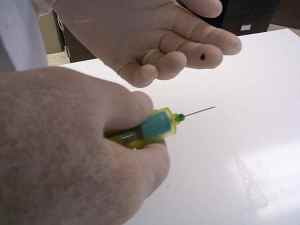Needlestick Injuries
September 27, 2010 2 Comments
Yesterday I cared for a nurse who was in tears – she had a needle stick exposure in the hospital and is nine weeks pregnant. Needle stick injuries are far too common in the hospital – approximately 600,000 to 800,000 needle stick and other percutaneous injuries are reported annually among US health care workers. And the true frequency is underestimated given that many health care workers do not report needle stick injuries. The operating room, of course, presents the greatest risk. Needle stick injuries place health care workers at risk for transmission of HIV, Hepatitis B, and Hepatitis C. An article in The New England Journal of Medicine, Needlestick Injuries Among Surgeons in Training, discusses the prevalence of needle sticks among surgery residents – and the all too high frequency (51%) with which they go unreported.
Here is some of the basic information. First question: if the percutaneous exposure involves a patient with Hepatitis B, HIV, or Hepatitis C, what is the seroconversion rate for the exposed person? For Hepatitis B, the seroconversion ranges from 23 to 62%, with higher rates associated with patients who are HBeAg positive, as compared to HBeAG negative. The seroconversion rate for HIV is 1:300, or 0.3% from a hollow-bore needle stick injury (Marcus, Surveillance of health care workers exposed to blood from patients infected with the human immunodeficiency virus, The New England Journal of Medicine 319: 1118–1123). The seroconversion rate for Hepatitis C is 1.8%.
Next question: how effective is treatment? For Hepatitis B, multiple doses of HBIG within 1 week of percutaneous exposure to HBsAg-positive blood provides 75% protection from HBV infection (Stevens et al., Perinatal hepatitis B virus transmission in the United States, JAMA 253: 1740-5). Hepatitis B vaccination (assuming you have an appropriate vaccine response, which can be determined by checking antibody titers) prior to a percutaneous needle exposure is the best way to prevent seroconversion.
For HIV, information is limited because seroconversion rates are low and studies are limited by small sample sizes. In one retrospective case-control study, after controlling for other risk factors for HIV transmission, use of zidovudine was associated with a reduction in the risk of HIV infection by 81% (95% CI of 43%-94%) (Cardo et al., A case-control study of HIV seroconversion in health care workers after percutaneous exposure, The New England Journal of Medicine 337: 1485-90). To be most effective, the treatment should be administered within an hour of possible exposure and no longer than 72 hours post-exposure.
For Hepatitis C, there is no approved prophylactic treatment available. There is no vaccine and no cure for the disease. And the virus, which can ultimately cause liver failure, is a serious one.
An excellent resource for more information, complete with references, is Updated U.S. Public Health Service Guidelines for the Management of Occupational Exposures to HBV, HCV, and HIV and Recommendations for Postexposure Prophylaxis.
There are a couple of frustrations with this process. First, although these percentages are useful when looking at the data objectively, it becomes difficult when it happens to you. After all, what do percentages matter if you end up on the wrong side of the data? What if you are the 1 in 300 who will convert to HIV or the 1 in 56 who will convert to HCV? The HIV post-exposure prophylaxis (PEP) medications have quite severe side effects, including nausea, vomiting, malaise, fatigue, and – for the pregnant woman – unknown consequences on fetuses less than 12 weeks. Thus, PEP is not without its consequences.
Second, it is still possible for patients to refuse to get tested for HIV. Laws vary on a state-by-state basis regarding the requirements for patient consent. This process can be frustrating for the exposed health care worker – and with good reason. Their lives are at stake – and no matter how small the risk, it still exists. The patient’s status can help the health care worker make a better informed decision regarding PEP.
When patients come into the hospital, they should agree to consent to HIV testing if a percutaneous exposure occurs. The health care worker should not be exposed to unnecessary anguish – and uncertainty – during this process simply because a patient refuses to consent. As health care workers, we willingly put ourselves at risk every day – for transmission of TB, meningitis, influenza, H1N1, and the list goes on. When the H1N1 pandemic broke last year, there were very few health care workers who refused to come to work – we were all there for our patients. Many emergency department workers put themselves at risk for physical and verbal abuse on a daily basis. I do not know many emergency health care workers who have not been exposed to blood, vomit, viruses, and other bodily fluids during their career. As a group, health care workers must accept that there are certain risks that come with this profession. But, to ease the added burden and stress that comes along with percutaneous exposure, the laws regarding patient consent in these situations need to be re-examined.


OUTSTANDING ARTICLE. I WILL USE THIS ARTICLE IN MY WEEKLY EMERGENCY MEDICINE EDUCATIONAL/READ GROUP. GLENN EKBLAD, DO, FACEP, FAAEM
A great article. As a UK solicitor specialising in Needlestick injuries the information and general awareness of Needlestick injuries lags behind that of the States. I’m building an online resource of information; http://www.needlestickclaims.co.uk/make-a-claim/needlestick_injury_resources and have linked to your excellent article. Best wishes, Mike Massen